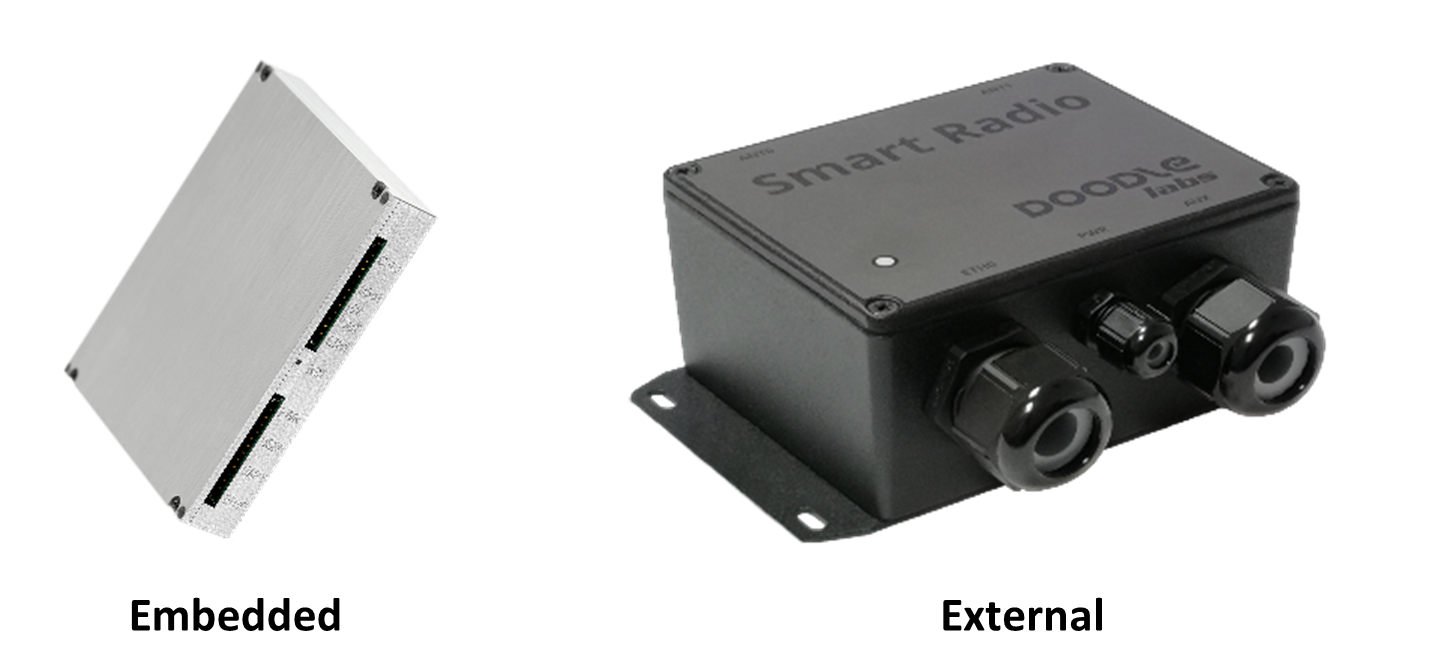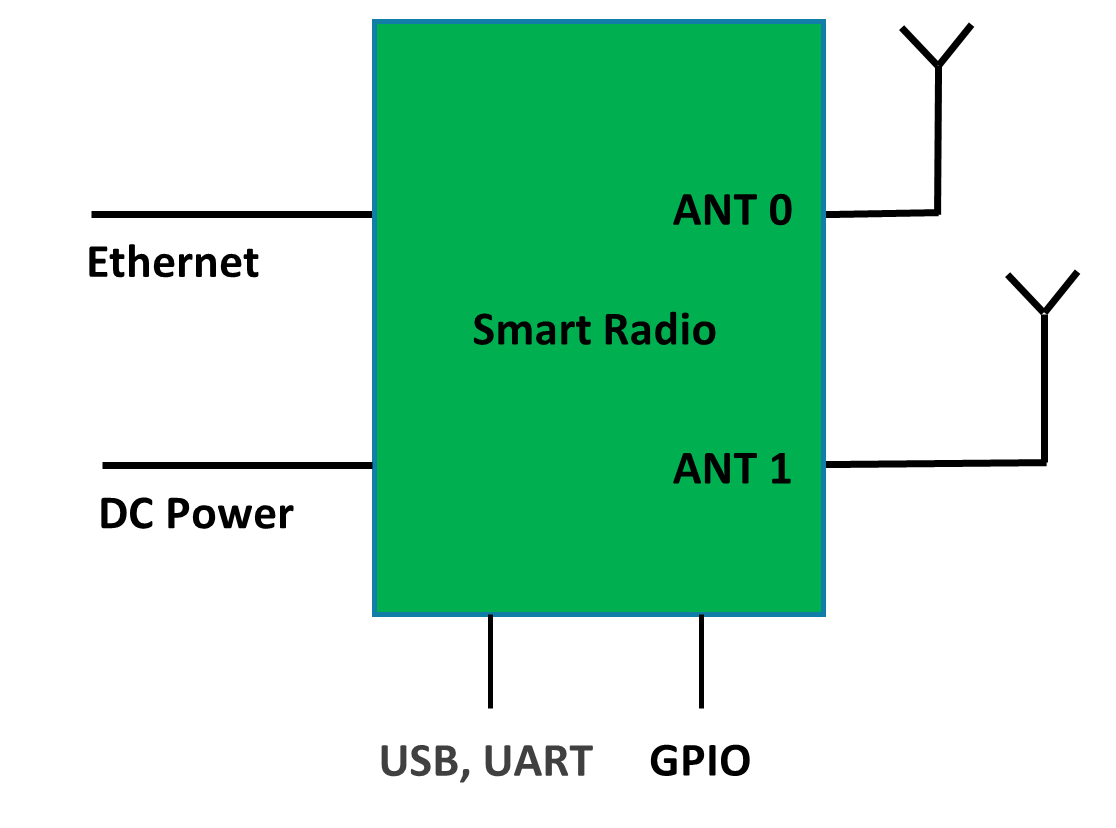Embedded/External Mesh Rider® Radio – 1350~1390 MHz
Overview

The Mesh Rider® Radio is an advanced 2×2 MIMO mesh router designed for easy plug & play integration. The tiny module carries all bi-directional communication (e.g. Telemetry, Video) in a single high-speed broadband RF channel.
Due to its very low SWaP-C (Space, Weight and Power and Cost), the Mesh Rider® Radio is very popular for mobile IIoT (Industrial Internet of Things) applications like drones, autonomous vehicles, and mobile robotics applications across various industries.
The Mesh Rider® Radio employs Doodle Labs' patented Mesh Rider® technology with state-of-the-art RF and networking capabilities that enable communication further, faster, and more reliably than any comparable solution on the market. For example, the Ultra Reliable Low Latency Channel (URLLC) transports important command and control data over the wireless link, while a concurrent video-optimized streaming channel carries crystal clear 4K video.
The Mesh Rider® Radio is available in many frequency bands between 100 MHz and 6 GHz in form-factor compatible models. This allows customers to switch the operating band by simply swapping the radio module, avoiding costly re-design efforts when expanding to new markets that require new frequencies. The Mesh Rider® Radio is available in embedded and external form factors.
For more information, please visit: https://doodlelabs.com/Mesh-Rider-radio/
Samples available on Mouser: https://www.mouser.com/search/refine.aspx?N=4248121056
Key Features - Mesh Rider® Radio Platform
PERFORMANCE RF
PERFORMANCE NETWORKING
ADDITIONAL FEATURES
Band Introduction – 900 MHz ISM Band
The 1370 MHz band ranges from 1350~1390 MHz. This band's transmission characteristics make it desirable to achieve a good balance of range and penetration for mobile ground-based robots. The RF signals at 1370 MHz have the ability to propagate further distances via two mechanisms: penetration and diffraction. Penetration refers to 1370 MHz waves ability to penetrate through building walls, vegetation and other obstacles. 1370 MHz waves can go through multiple building walls making it an excellent choice for applications that do not have a direct line of sight between sender and receiver. Diffraction describes the characteristic of a 1370 MHz wave that it can go around an object such as a building or vegetation. 1370 MHz waves have smaller Fresnel zone.
The DoD operates telemetry systems in this band that are used to transmit and receive data from airborne vehicles at test and training ranges. Additionally, the DoD operates transportable tactical point-to point communication systems in the 1370 MHz band. These tactical communication systems are used for command and control networks for military ground forces. This is the only transmission media available to the Marine Corps with sufficient bandwidth to carry large quantities of critical data such as maps, overlays, intelligence pictures, and other data to the battlefield commanders. These systems are used within the United States for comprehensive and realistic training to maintain a high level of combat readiness. The DoD will continue to operate tactical transportable fixed point-to-point communication systems in this band for the foreseeable future.
System Integration

The Mesh Rider® Radio is an embedded module. It has been designed to be nearly plug and play. Only Ethernet, power supply (5.5~42V), and antenna connections are required for integration.
Doodle Labs provides the following documents upon request: integration guide, 3D CAD model, mechanical drawing, cable drawing, and thermal map.
Visit Doodle Labs Technical Library for extensive design-in documents.
Technical Specifications (1350~1390 M)
| Model Category | XTreme |
|---|---|
| ORDERING CODES | |
| Radio Configuration | 2x2 MIMO |
| Model # (v3 hardware) |
RM-1370-2J-XM (Embedded, Industrial temp) RM-1370-2J-XM-C (Embedded, Commercial temp) RM-1370-2J-XE (External, Industrial temp) RM-1370-2J-XE-C (External, Commercial temp) |
| Model options | Integrated GPS – add G suffix PoE (External only) – add O suffix |
| Evaluation Kit (Optional) | EK-1370-2J (Ethernet board for Embedded model) |
| Design-In Documentation | Doodle Labs Technical Library |
| PERFORMANCE OVERVIEW | |
| Data Throughput at 10-meter range with Attached 3 dBi Antennas (Indicative) | 80 Mbps (20 MHz Channel) 40 Mbps (10 MHz Channel) 20 Mbps (5 MHz Channel) 12 Mbps (3 MHz Channel) |
| Over the Air Data Encryption | 128-bit AES (Full throughput) 256-bit AES (12 Mbps max throughput) |
| FIPS Certification (Optional) | FIPS 140-3 |
| Operating Modes | Mesh, WDS AP, WDS Client Bridged or Internet Gateway with NAT |
| Command & Control channel | Ultra-Reliable Low Latency Channel (URLLC). Latency 1.5-10 ms |
| Video Channel | Optimized video streaming with Unicast and Multicast transmission |
| RF SPECIFICATIONS | |
| Protocol Compatibility | Fully compatible with Doodle Labs Mesh Rider Waveform |
| Frequency Range | 1350-1370 MHz |
| Advanced Band Filters | Dedicated SAW filters for high interference immunity |
| Max RF Power at SMA port (Software control) Each radio individually calibrated |
1.0W (30 dBm) @ MCS 0,8 0.8W (29 dBm) @ MCS 3,11 0.4W (26 dBm) @ MCS 5,13 250mW (24 dBm) @MCS 7,15 |
| Channel Sizes (Software Selectable) |
3, 5, 10, 20 MHz |
| Radio Data Rate | Auto adapting Modulation Coding Scheme (MCS0-15) |
| Antenna Signal Strength | -25 to -85 dBm (Recommended), Absolute Maximum= +12 dBm |
| RF Power Control | In 1 dBm steps, Tolerance ±1 dBm |
| Automatic Transmit Power Control (ATPC) | Intelligently adjusts the transmit power for very close range operation |
| Integrated Antenna Port Protection | Able to withstand open port, >10 KV (contact) and >15KV (open air discharge) as per IEC-61000-4-2 |
| Wireless Error Correction | FEC, ARQ |
| Receive Noise Figure | +4 dB |
| Receive Adjacent Channel Rejection (ACRR) | 34 dB @ MCS0 for 20 MHz channel (Typ) |
| Transmitter Adjacent Channel Leakage Ratio (ACLR) | < 28 dBr (Fc ± ChBW) |
| Transmitter Spurious Emission Suppression | < 55 dBc |
| Frequency Accuracy | ±10 ppm max over life |
| Control for External Power Amp | DC biased signal over RF port |
| NETWORKING SPECIFICATIONS | |
| Mesh Router | Self-Forming/Self-Healing, Peer to Peer |
| Custom Software Package Manager | Image Builder, OPKG, ipk |
| Radio Management | Web GUI (HTTPs), SSH and JSON-RPC |
| Access control | Password, MAC, IP, Port filtering |
| Supported Protocols | IPv6, QoS, DNS, HTTPS, IP, ICMP, NTP, DHCP |
| Software Upgrade | Over the air software upgrade supported |
| HARDWARE SPECIFICATIONS | |
| Case Material | Aluminum (Embedded & External) |
| Power Input | 6V - 42V DC (EOL August 2022) 6V - 32V DC External supports passive POE |
| DC Power Consumption | 10W @ Max RF power in UDP data Tx mode 4W in Rx mode 1.2W in Standby mode |
| Dimensions | 65 x 57 x 12 mm, 78 grams (Embedded) 148 x 137 x 58 mm, 540 grams (External) |
| Mesh Rider Antenna Ports | 2x MMCX-Female (Embedded) 2x SMA-Female (External) |
| Host Interface | 2x Ethernet (100 Base-T), 1x UART (3.3V), 2x USB 2.0 Host, 2x GPIO (Embedded) 2x Ethernet (100 Base-T), 1x UART (RS232), 2x USB 2.0 Host, 2x GPIO (External) |
| Temperature range (Operating) | Industrial: -40°C to +85°C, Commercial: -10°C to +65°C * System's thermal design should ensure that the radio's case temperature is maintained within these specifications. |
| Ingress Protection | IP 50 (Embedded), Dust Protected, No Liquids IP66 — Protected from high pressure water jets from any direction. |
| Relative Humidity | 5% to 95% non-condensing |
| Shock and Vibration Resistance | Compliant to MIL-STD-810H for high shock and vibration |
| Reliability | Extreme Reliability, IPC Class 2 standard with Class 3 options |
| Integrated GPS (optional) | Simultaneous multiple constellations (GPS/Galileo/Glonass/BeiDou/QZSS), 1.5 meter CEP position accuracy, -163 dBm tracking sensitivitym |
| Integrated GPS Module with LNA | u-blox MAX-M8 series Concurrent GNSS Module (u-blox.com) |
| GPS Antenna | SMA-Female connector for external Passive antenna (External) MMCX-Female connector for external Passive antenna (Embedded) (use of Active GPS antenna is not recommended) |
| Integrated CPU | MIPS 24Kc, 540 MHz, 32MB Flash, 64MB DDR2 RAM |
| ESD Protection | IEC 61000-4-2 test criteria, Level 3 (±6KV) for Contact Discharge and Level 4 (±15KV) for Air Discharge |
| MTBF | >235k hours (25 years) |
| Life Cycle Planning | Extended lifespan with 7 years guaranteed availability |
| REGULATORY INFORMATION | |
| Regulatory Requirements | Designed and verified to meet various regulatory requirements. Formal testing and approval are required for the Integrator's antenna type. The Integrator is responsible for obtaining all regulatory approvals in target markets for the finished product. | RoHS/WEEE Compliance | Yes. 100% Recyclable/Biodegradable packaging |
| EXPORT INFORMATION | |
| ECCN Code | 5A992 |
| HS Code | 85256010 |
| ADDITIONAL RF SPECIFICATIONS | ||||
|---|---|---|---|---|
| MCS Rate | Modulation | Combined Output Power (dBm) | Sensitivity (dBm) | UDP Throughput (Mbps) |
| 0 | BPSK (1/2) | 30 | -93 | 5.4 |
| 1 | QPSK (1/2) | 29 | -90 | 10.62 |
| 2 | QPSK (3/4) | 29 | -88 | 15.66 |
| 3 | 16-QAM (1/2) | 29 | -85 | 20.52 |
| 4 | 16-QAM (3/4) | 27 | -80 | 29.88 |
| 5 | 64-QAM (2/3) | 26 | -78 | 38.88 |
| 6 | 64-QAM (3/4) | 25 | -75 | 43.11 |
| 7 | 64-QAM (5/6) | 24 | -72 | 47.34 |
| 8 | BPSK (1/2) | 30 | -90 | 10.53 |
| 9 | QPSK (1/2) | 29 | -86 | 20.43 |
| 10 | QPSK (3/4) | 29 | -84 | 29.7 |
| 11 | 16-QAM (1/2) | 29 | -81 | 38.52 |
| 12 | 16-QAM (3/4) | 27 | -77 | 54.72 |
| 13 | 64-QAM (2/3) | 26 | -73 | 69.3 |
| 14 | 64-QAM (3/4) | 25 | -72 | 76.14 |
| 15 | 64-QAM (5/6) | 24 | -71 | 82.8 |
Note 1: Performance based on 20-MHz bandwidth
Note 2: Sensitivity and throughput are approximately proportional to bandwidth.